5.11.2025
Weltraumschrott trifft Raumkapsel – Astronauten sitzen fest

Die Crew der "Shenzhou 20" hätte heute wieder in der Wüste Gobi landen sollen. (Quelle: IMAGO / Yuan Quan)
Weil eine Raumkapsel vermutlich von Weltraumschrott getroffen wurde, können chinesische Raumfahrer nicht zur Erde zurückkehren. Was bedeutet das?

China verschiebt die ursprünglich für heute geplante Rückkehr dreier Astronauten von seiner Raumstation "Tiangong" ("Himmelspalast") auf die Erde. Grund sei der Verdacht auf einen Zusammenprall der Raumkapsel mit Weltraumschrott, teilte die Behörde für bemannte Raumfahrt in Peking mit.
Demnach laufen derzeit die Analyse und die Abwägung der Risiken, heißt es. Die Mission werde bis auf Weiteres verschoben, um die Sicherheit der Astronauten zu gewährleisten.
Weltraumschrott ist eine Gefahr für Raumstationen
Weltraumschrott ist schon länger ein Problem im All. Darunter versteht man alle nicht mehr verwendeten Objekte wie Satelliten oder Bruchstücke davon, die aus Kollisionen oder Explosionen entstanden sind. Sie können winzig klein oder auch mehrere Meter groß sein.
Im vergangenen Jahr wurde die chinesische Raumstation "Tiangong" bereits von Weltraumschrott getroffen und musste dann gewartet werden. Auch die Internationale Raumstation ISS muss immer wieder Trümmerteilen ausweichen.
Mitunter mussten sich Astronauten in angedockten Raumfahrzeugen in Sicherheit bringen, weil solche Geschosse auf einem möglichen Kollisionskurs waren.
Übergabe mit neuer Crew
Eigentlich hätte die Crew der "Shenzhou 20" heute wieder in der Wüste Gobi in Chinas Nordwesten landen sollen. Die Astronauten Chen Dong, Chen Zhongrui und Wang Jie hatten rund ein halbes Jahr im All unter anderem wissenschaftliche Experimente durchgeführt und den Schutz der Raumstation gegen Weltraumschrott ausgebaut.
Zuvor hatte China drei neue Astronauten ins All geschickt, mit denen in den vergangenen Tagen die Übergabe der Raumstation erfolgt war. Auch die neue "Shenzhou 21"-Crew soll die Raumstation warten, wissenschaftliche Experimente durchführen und Weltraumspaziergänge absolvieren.
Quelle: t-online.de
+++
China postpones Shenzhou-20 return mission
BEIJING, Nov. 5 (Xinhua) -- The return of China's Shenzhou-20 crewed spaceship, originally scheduled for Wednesday, will be postponed due to a suspected impact from tiny space debris, the China Manned Space Agency (CMSA) announced.
The impact analysis and risk assessment are under way, the CMSA said.
The decision to delay the return aims to ensure the astronauts' safety and mission success, the agency said.
Quelle: Xinhua
----
Update: 7.11.2025
.
Suspected Space Debris Impact Postpones Shenzhou-20 Return

The return of three Shenzhou-20 crewmembers to Earth on Nov. 5 from the Tiangong space station has been postponed due to a “suspected impact from tiny space debris” on the spacecraft’s return capsule, a statement from the China Manned Space Agency (CMSA) says.
The agency said it is conducting an impact analysis and risk assessment. No updated return date was provided.
While a previous Shenzhou-19 mission return was delayed due to poor weather at the landing site, this marks the first time in the program’s history that a return to Earth has been postponed because of a space debris incident.
Space debris is a persistent concern for the Tiangong. Several of its extravehicular activities have involved damage inspections, repairs, and the installation of enhanced protection shields.
The Shenzhou-21 spacecraft, which docked with Tiangong on Nov. 1, is available to return the crew who have been in orbit since April 24. Previous CMSA briefings said crews can use a newly arrived capsule—in this case, Shenzhou-21—if their original spacecraft is compromised.
A Long March 2F rocket and a Shenzhou capsule are always on standby at the Jiuquan Satellite Launch Center and can be launched within days if needed.
Separately, CMSA announced four missions in 2026 in support of the Tiangong space station. Planned missions include the Tianzhou-10 cargo mission, the crewed Shenzhou-22 and Shenzhou-23 missions, and the new Mengzhou-1 module. Notably, one crewmember from Shenzhou-22 is scheduled to remain in orbit for more than a year, which would set a new endurance record for China’s crewed space program.
Quelle: AVIATION WEEK
----
Update: 12.11.2025
.
Return mission for Shenzhou-20 astronauts proceeds smoothly
Work on the return mission of China's Shenzhou-20 astronaut crew is proceeding in an orderly manner as planned, the China Manned Space Agency (CMSA) announced on Tuesday.
After the return mission was postponed, emergency response plans and measures were immediately activated, and a comprehensive simulation analysis, testing, and safety assessment of the Shenzhou-20 manned spacecraft were conducted to study the return implementation plan for the Shenzhou-20 crew, the CMSA said.
All systems are rigorously conducting joint tests as required, while key product status reviews and quality confirmations are carried out. Concurrently, the landing site is performing comprehensive exercises for the crew's return.
The space station combination is operating normally and has the capacity to support two crews' stay in orbit. The Shenzhou-20 crew works and lives normally onboard and is jointly conducting in-orbit scientific experiments with the Shenzhou-21 crew, the agency said.
Quelle: Xinhua
----
Update: 26.11.2025
.
China's Shenzhou-22 spaceship docks with space station combination
China's Shenzhou-22 spaceship successfully docked with the space station combination Tuesday, according to the China Manned Space Agency.
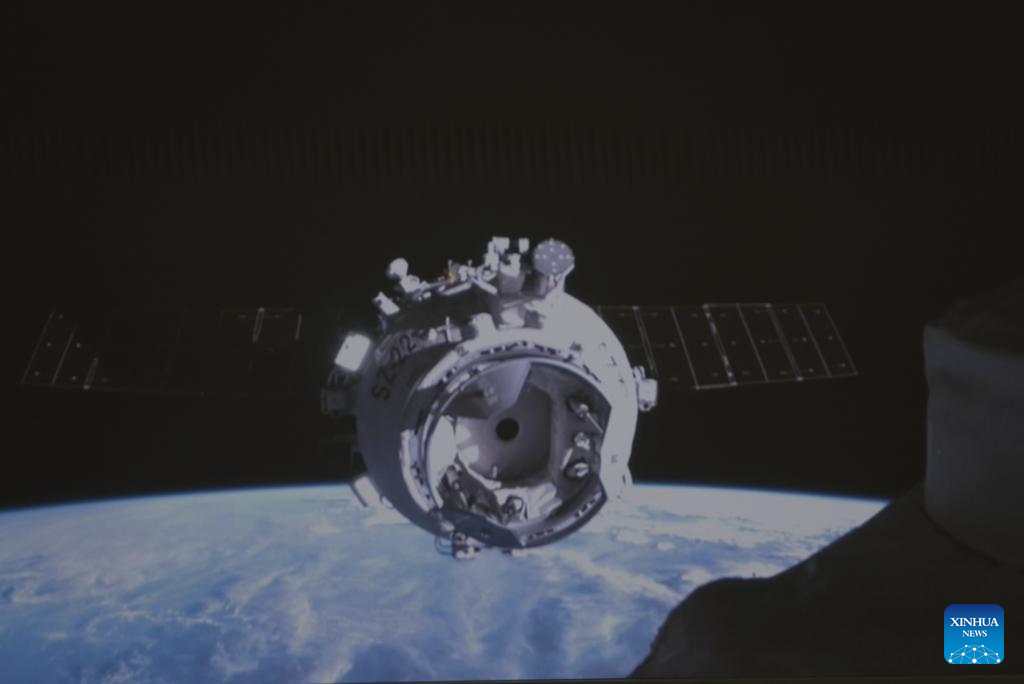
This real-time image captured at the Beijing Aerospace Control Center on Nov. 25, 2025 shows the Shenzhou-22 spaceship docking with the space station combination. China's Shenzhou-22 spaceship successfully docked with the space station combination Tuesday, according to the China Manned Space Agency. (Xinhua/Wang Chuntao)

This simulated image captured at the Beijing Aerospace Control Center on Nov. 25, 2025 shows the Shenzhou-22 spaceship docking with the space station combination. China's Shenzhou-22 spaceship successfully docked with the space station combination Tuesday, according to the China Manned Space Agency. (Xinhua/Wang Chuntao)

This real-time image captured at the Beijing Aerospace Control Center on Nov. 25, 2025 shows the Shenzhou-22 spaceship docking with the space station combination. China's Shenzhou-22 spaceship successfully docked with the space station combination Tuesday, according to the China Manned Space Agency. (Xinhua/Wang Chuntao)

Technicians monitor the docking of Shenzhou-22 spaceship with the space station combination at the Beijing Aerospace Control Center on Nov. 25, 2025. China's Shenzhou-22 spaceship successfully docked with the space station combination Tuesday, according to the China Manned Space Agency. (Xinhua/Wang Chuntao)

This simulated image captured at the Beijing Aerospace Control Center on Nov. 25, 2025 shows the Shenzhou-22 spaceship docking with the space station combination. China's Shenzhou-22 spaceship successfully docked with the space station combination Tuesday, according to the China Manned Space Agency. (Xinhua/Wang Chuntao)
Quelle: Xinhua
----
Update: 10.12.2025
.
Shenzhou-21 astronauts complete first series of extravehicular activities
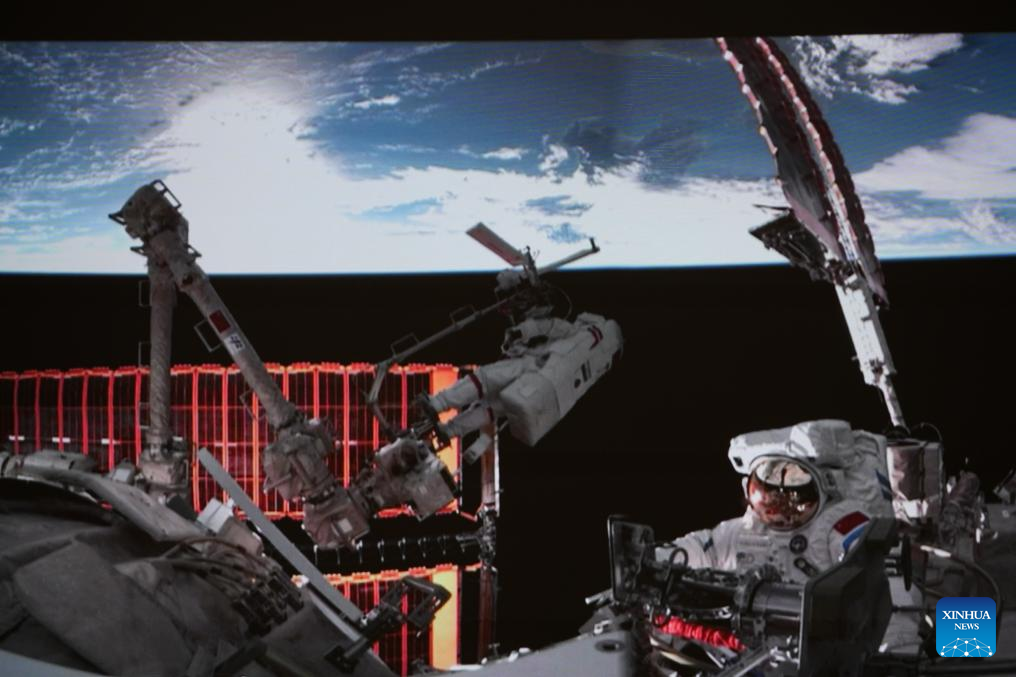
This screen image captured at Beijing Aerospace Control Center on Dec. 9, 2025 shows Shenzhou-21 astronauts performing extravehicular activities outside China's orbiting space station. (Xinhua/Liu Yi)
The Shenzhou-21 crew aboard China's orbiting space station completed their mission's first series of extravehicular activities on Tuesday, according to the China Manned Space Agency.
Quelle: Xinhua
----
Update: 11.12.2025
.
New spacesuits debuted for Shenzhou-21's first spacewalk
Shenzhou-21 astronauts Zhang Lu and Wu Fei completed the first series of extravehicular activities (EVAs) of their mission on Tuesday, donning newly delivered extravehicular spacesuits for their inaugural use in space.
The mission marked the debut of the space station's D and E extravehicular spacesuits, which were delivered by the Tianzhou-9 cargo spacecraft on July 15 as part of the second-generation Feitian spacesuit series. While maintaining white as the primary color, one suit features a red trim and the other a blue trim.
"The EVAs fully demonstrated the critical role of human capabilities in extravehicular operations, with the suits providing robust safety assurance for astronauts," said Zhai Zhihong from the China Astronaut Research and Training Center.
The operational lifespan of the suits has been upgraded from the previous standard of 15 EVAs over three years to 20 EVAs within four years, according to the center.
The second-generation Feitian extravehicular spacesuits have reliably supported all EVAs conducted during both the construction and operational phases of China's space station.
Quelle: Xinhua
+++
Shenzhou-21 astronauts complete first series of extravehicular activities
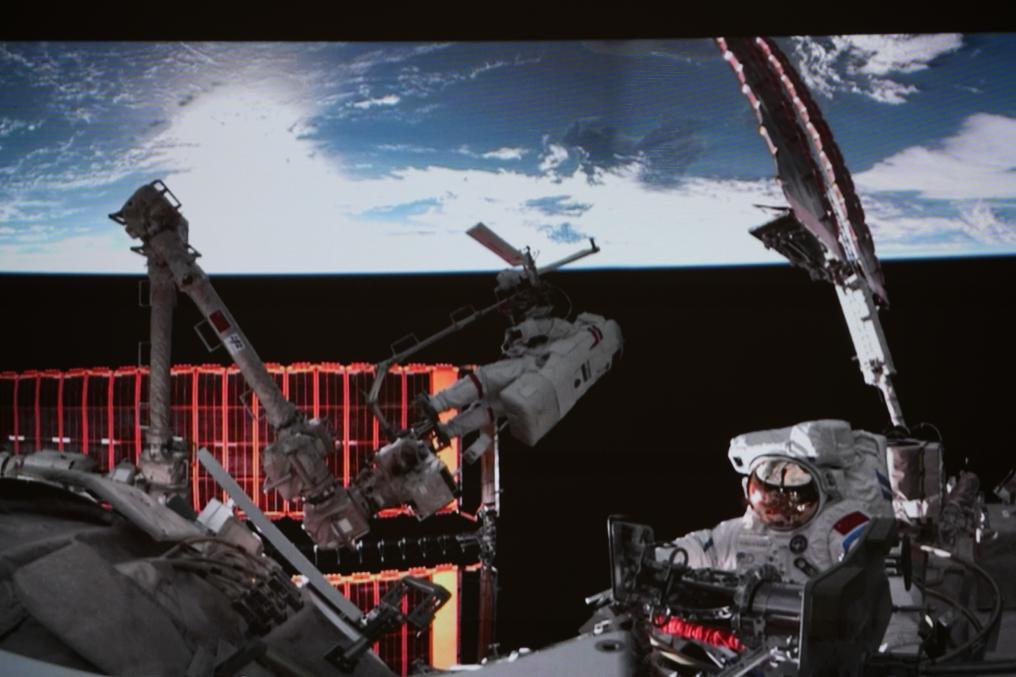
This screen image captured at Beijing Aerospace Control Center on Dec. 9, 2025 shows Shenzhou-21 astronauts performing extravehicular activities outside China's orbiting space station. (Xinhua/Liu Yi)
The Shenzhou-21 crew aboard China's orbiting space station completed their mission's first series of extravehicular activities on Tuesday, according to the China Manned Space Agency (CMSA).
The astronaut trio -- Zhang Lu, Wu Fei and Zhang Hongzhang -- worked for approximately eight hours and completed their tasks at 6:45 p.m. (Beijing Time), assisted by the space station's robotic arm and a team on Earth. Wu Fei is the youngest Chinese astronaut to carry out an extravehicular mission to date.
Zhang Lu and Wu Fei, tasked with conducting spacewalk operations, completed the inspection and photography of the Shenzhou-20 return capsule's viewport window, the installation of a debris protection device for the space station, and the replacement of the multilayer cover on the thermal control adapter, according to the CMSA.
During the Shenzhou-21 crewed mission, planned extravehicular activities involving crew and applied payloads will also be conducted, as will scientific experiments and technical tests.
Depending on the situation determined, the crew may also undertake protective operations on the damaged window of the Shenzhou-20 spacecraft, according to the CMSA. ■
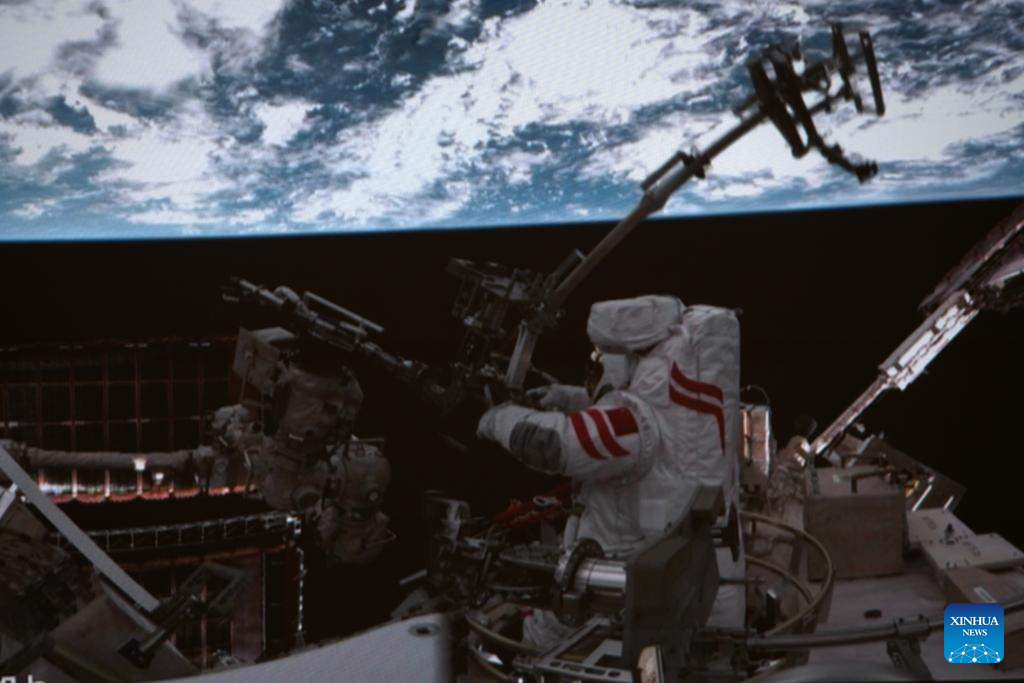
This screen image captured at Beijing Aerospace Control Center on Dec. 9, 2025 shows Shenzhou-21 astronaut Zhang Lu performing extravehicular activities outside China's orbiting space station. (Xinhua/Liu Yi)
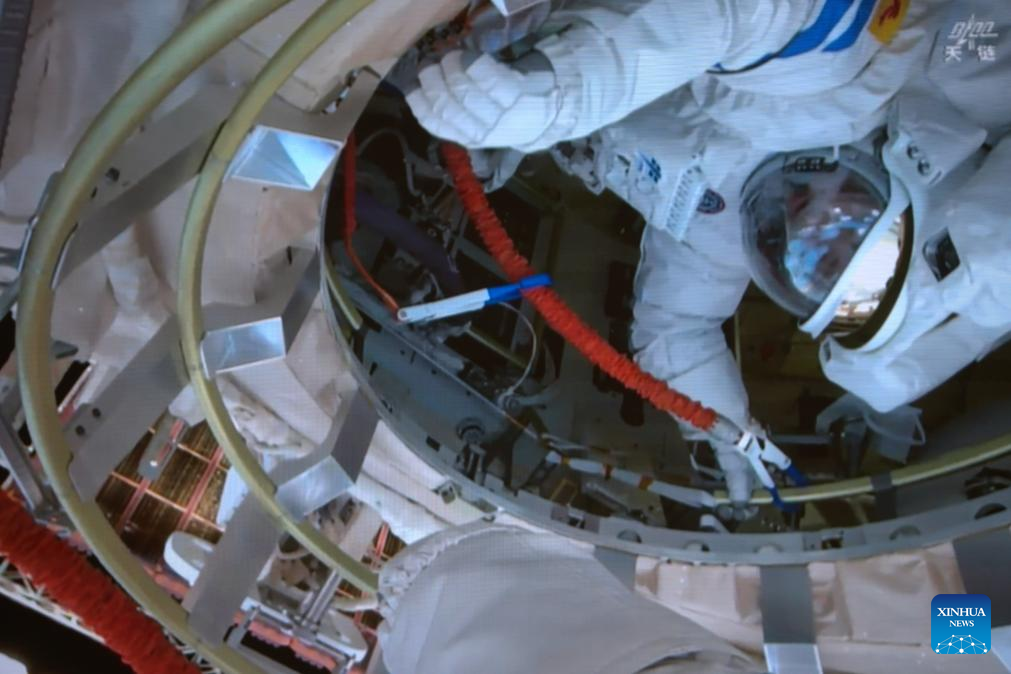
This screen image captured at Beijing Aerospace Control Center on Dec. 9, 2025 shows Shenzhou-21 astronaut Wu Fei (above) passing a piece of equipment to Zhang Lu outside China's orbiting space station. (Xinhua/Liu Yi)

This screen image captured at Beijing Aerospace Control Center on Dec. 9, 2025 shows Shenzhou-21 astronaut Zhang Lu performing extravehicular activities outside China's orbiting space station. (Xinhua/Liu Yi)
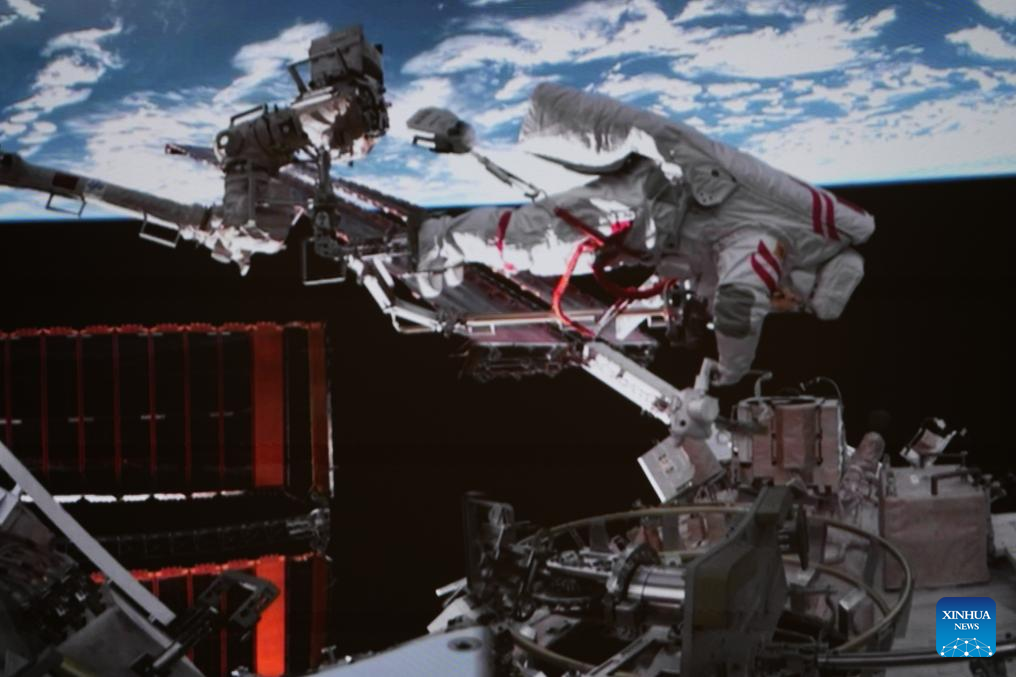
This screen image captured at Beijing Aerospace Control Center on Dec. 9, 2025 shows Shenzhou-21 astronaut Zhang Lu performing extravehicular activities outside China's orbiting space station. (Xinhua/Liu Yi)

This screen image captured at Beijing Aerospace Control Center on Dec. 9, 2025 shows Shenzhou-21 astronaut Zhang Lu performing the inspection and photography of the Shenzhou-20 return capsule's viewport window outside China's orbiting space station. (Xinhua/Liu Yi)
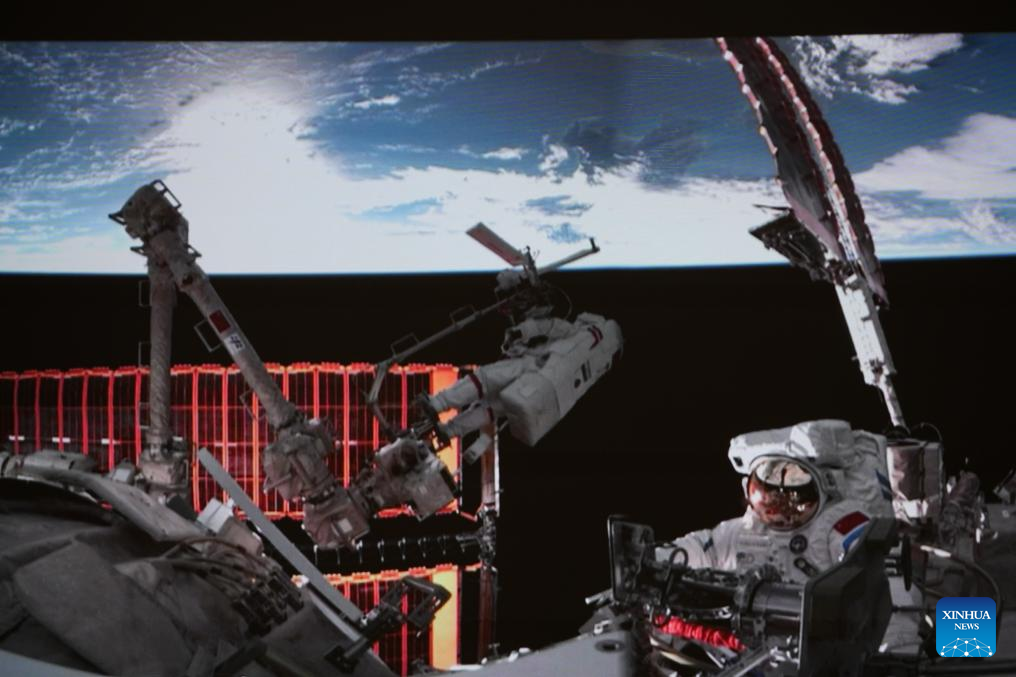
This screen image captured at Beijing Aerospace Control Center on Dec. 9, 2025 shows Shenzhou-21 astronauts Zhang Lu and Wu Fei (R) performing extravehicular activities outside China's orbiting space station. (Xinhua/Liu Yi)
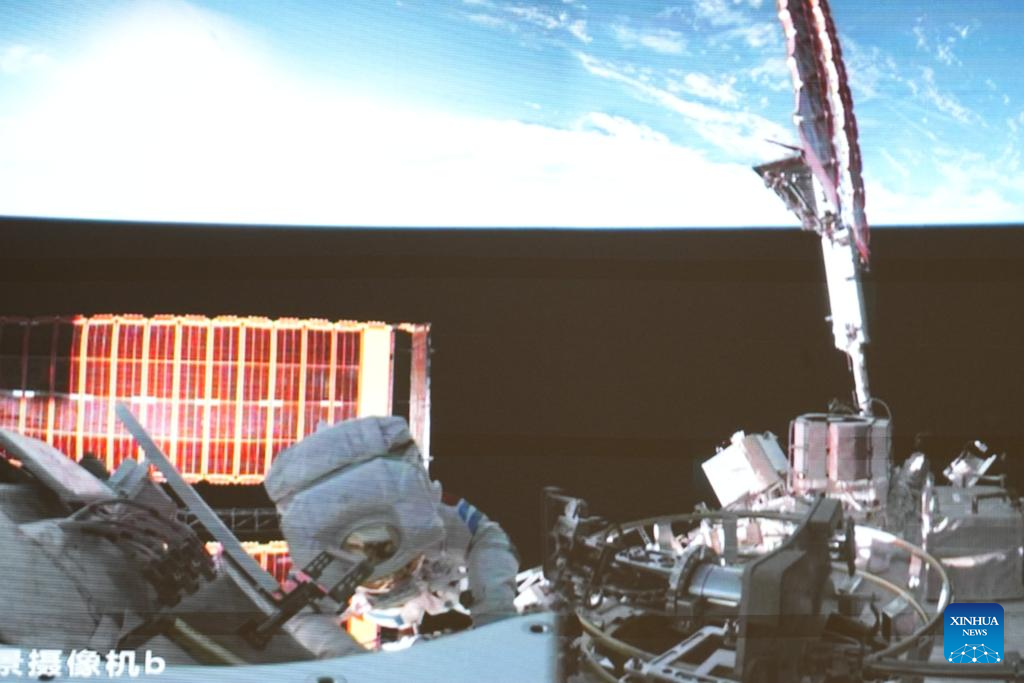
This screen image captured at Beijing Aerospace Control Center on Dec. 9, 2025 shows Shenzhou-21 astronaut Wu Fei performing extravehicular activities outside China's orbiting space station. (Xinhua/Liu Yi)
Quelle: Xinhua
